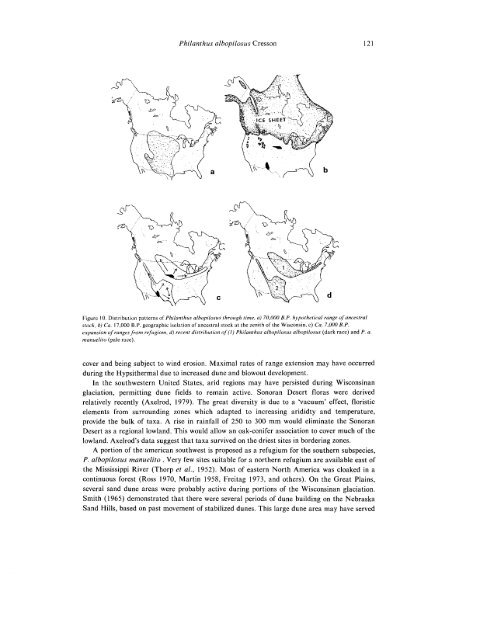Hilchie 1982 QEv18n1_4 91_126 CC released.pdf - College of ...
Hilchie 1982 QEv18n1_4 91_126 CC released.pdf - College of ...
Hilchie 1982 QEv18n1_4 91_126 CC released.pdf - College of ...
Create successful ePaper yourself
Turn your PDF publications into a flip-book with our unique Google optimized e-Paper software.
Philanthus albopilosus Cresson 121<br />
Figure 10. Distribution patterns <strong>of</strong> Philanthus albopilosus through lime, a) 70.000 B.P. hypothetical range <strong>of</strong> ancestral<br />
stock, b) Ca. 17,000 B.P. geographic isolation <strong>of</strong> ancestral stock at the zenith <strong>of</strong> the Wisconsin, c) Ca. 7,000 B.P.<br />
expansion <strong>of</strong> ranges from refugiom. d) recent distribution <strong>of</strong> (I) Philanthus albopilosus albopilosus (dark race) and P. a.<br />
manuelito (pale race).<br />
cover and being subject to wind erosion. Maximal rates <strong>of</strong> range extension may have occurred<br />
during the Hypsithermal due to increased dune and blowout development.<br />
In the southwestern United States, arid regions may have persisted during Wisconsinan<br />
glaciation, permitting dune fields to remain active. Sonoran Desert floras were derived<br />
relatively recently (Axelrod, 1979). The great diversity is due to a 'vacuum' effect, floristic<br />
elements from surrounding zones which adapted to increasing arididty and temperature,<br />
provide the bulk <strong>of</strong> taxa. A rise in rainfall <strong>of</strong> 250 to 300 mm would eliminate the Sonoran<br />
Desert as a regional lowland. This would allow an oak-conifer association to cover much <strong>of</strong> the<br />
lowland. Axelrod's data suggest that taxa survived on the driest sites in bordering zones.<br />
A portion <strong>of</strong> the american southwest is proposed as a refugium for the southern subspecies,<br />
P. albopilosus manuelito . Very few sites suitable for a northern refugium are available east <strong>of</strong><br />
the Mississippi River (Thorp et al., 1952). Most <strong>of</strong> eastern North America was cloaked in a<br />
continuous forest (Ross 1970, Martin 1958, Freitag 1973, and others). On the Great Plains,<br />
several sand dune areas were probably active during portions <strong>of</strong> the Wisconsinan glaciation.<br />
Smith (1965) demonstrated that there were several periods <strong>of</strong> dune building on the Nebraska<br />
Sand Hills, based on past movement <strong>of</strong> stabilized dunes. This large dune area may have served
















